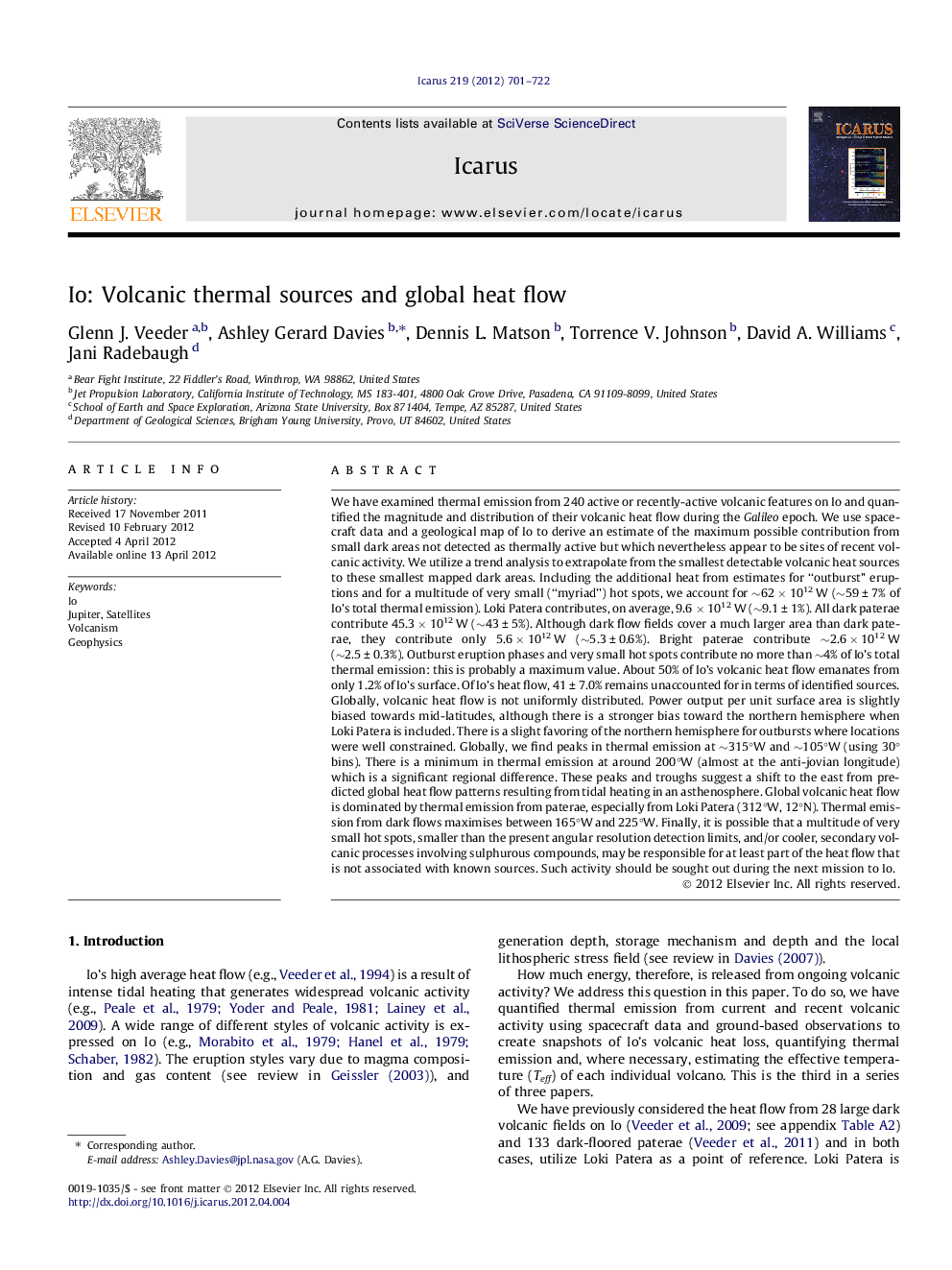| کد مقاله | کد نشریه | سال انتشار | مقاله انگلیسی | نسخه تمام متن |
|---|---|---|---|---|
| 1773600 | 1021140 | 2012 | 22 صفحه PDF | دانلود رایگان |

We have examined thermal emission from 240 active or recently-active volcanic features on Io and quantified the magnitude and distribution of their volcanic heat flow during the Galileo epoch. We use spacecraft data and a geological map of Io to derive an estimate of the maximum possible contribution from small dark areas not detected as thermally active but which nevertheless appear to be sites of recent volcanic activity. We utilize a trend analysis to extrapolate from the smallest detectable volcanic heat sources to these smallest mapped dark areas. Including the additional heat from estimates for “outburst” eruptions and for a multitude of very small (“myriad”) hot spots, we account for ∼62 × 1012 W (∼59 ± 7% of Io’s total thermal emission). Loki Patera contributes, on average, 9.6 × 1012 W (∼9.1 ± 1%). All dark paterae contribute 45.3 × 1012 W (∼43 ± 5%). Although dark flow fields cover a much larger area than dark paterae, they contribute only 5.6 × 1012 W (∼5.3 ± 0.6%). Bright paterae contribute ∼2.6 × 1012 W (∼2.5 ± 0.3%). Outburst eruption phases and very small hot spots contribute no more than ∼4% of Io’s total thermal emission: this is probably a maximum value. About 50% of Io’s volcanic heat flow emanates from only 1.2% of Io’s surface. Of Io’s heat flow, 41 ± 7.0% remains unaccounted for in terms of identified sources. Globally, volcanic heat flow is not uniformly distributed. Power output per unit surface area is slightly biased towards mid-latitudes, although there is a stronger bias toward the northern hemisphere when Loki Patera is included. There is a slight favoring of the northern hemisphere for outbursts where locations were well constrained. Globally, we find peaks in thermal emission at ∼315°W and ∼105°W (using 30° bins). There is a minimum in thermal emission at around 200°W (almost at the anti-jovian longitude) which is a significant regional difference. These peaks and troughs suggest a shift to the east from predicted global heat flow patterns resulting from tidal heating in an asthenosphere. Global volcanic heat flow is dominated by thermal emission from paterae, especially from Loki Patera (312°W, 12°N). Thermal emission from dark flows maximises between 165°W and 225°W. Finally, it is possible that a multitude of very small hot spots, smaller than the present angular resolution detection limits, and/or cooler, secondary volcanic processes involving sulphurous compounds, may be responsible for at least part of the heat flow that is not associated with known sources. Such activity should be sought out during the next mission to Io.
► Thermal emission from 240 volcanic features on Io equals 55% of Io’s total heat flow.
► Energy emanating from paterae alone represents 46% of Io’s total heat flow of ∼1014 W.
► Paterae heat flow has a bimodal longitudinal distribution (peaks at 315 W and 105 W).
► Slight bias towards volcanic heat flow at mid-latitudes; also, a minimum at ∼200 W.
► Peak thermal emission offset eastwards from asthenospheric tidal heating models.
Journal: Icarus - Volume 219, Issue 2, June 2012, Pages 701–722